A steaming bowl of fragrant ph? is thought to have almost magical properties ? the ability to cure disease, soothe hangovers and restore the body?s balance.
Vietnam?s unofficial national dish is much loved, and widely traveled, available from Montreal to Melbourne and Moscow.
Ph? is Vietnamese soul food, comfort food and often a Sunday morning ritual, when families gather to savor giant bowls of cinnamon and star anise-scented broth, soft rice noodles, slices of meat, onion, shallots and crunchy bean sprouts.
It?s a closely-kept Vietnamese secret that ph? is more than just a noodle soup and a type of fresh rice noodle. There are many different types of ph?, and some aren?t even soups.
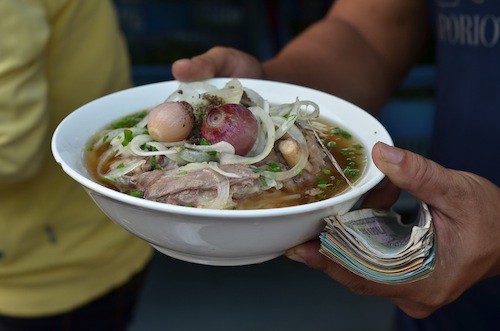
Ph? noodle soup originated from the north of Vietnam in the early 1900s, when Vietnam was part of French Indochina. The origins of ph? are murky (unlike the soup itself) and slightly controversial.
Before the French came to Vietnam, beef was rarely eaten by Vietnamese people. Water buffalo was much more common, and cheaper.
One version of the ph? creation story is that a Chinese wandering vendor began collecting discarded beef bones from French households and reusing them to make a soup featuring thin flat rice noodles called ?fun? or ?fan? in Chinese. He sold the soup from gnh ph?, baskets hanging from shoulder poles, keeping his wares hot with a little brazier (feu is French for ?fire?).
Some say the word ph? is derived from the Chinese name of the noodles, or a Chinese beef noodle soup called ng?u nh?c ph?n which was popular in the north of Vietnam. Others say it?s a corruption of the French word feu, or a local version of the French beef and vegetable dish called pot-au-feu (pot on the fire).
Another, more politically acceptable story ? because you don?t want your national dish linked to your former oppressors ? is that the soup originated in the villages of Vn C and Dao C in Nam Dinh Province north of Hanoi. (China ruled Vietnam for about 1,000 years and the French ruled for about 100 years.) According to this non-French, non-Chinese ph? story, the original ph? vendors wore felt hats known as m? ph?, and sold their soup from the handy gnh ph? shoulder poles.
There?s also a story that ph? evolved from a dish called xo tru, popular in the markets in Hanoi in the early 1900s. Xo tru was a water buffalo and noodle soup flavoured with onion, Vietnamese mint and starfruit.
Where ever it came from, the soup traveled south through central and south Vietnam. In the 70s and 80s ph? left its country of origin, traveling across the seas with the Southern Vietnamese who fled Communist Vietnam?s economic hardship and political reprisals.
The Different Types of Pho
Ph? H N?i (Hanoi-style pho)

Hanoi is the home of ph? and in the north they keep it simple. The broth should be clear, with a thin layer of oil on top to give it a ?silky? feel. The only accompaniments to the steaming bowl of soup are small dishes of bean sprouts, lime wedges and chopped chili.
Hanoians regard the original form of ph? as a sophisticated dish. The broth should be clear and so full of flavor that nothing needs to be added. Hanoi ph? cooks use more ginger and are more liberal with the salt than ph? cooks in other parts of Vietnam. Hanoi ph? noodles are also cut slightly fatter than Southern ph? noodles.
Ph? Si Gn (Saigon-style pho)
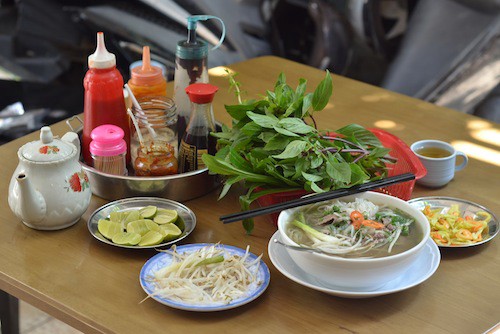
Southerners have ?improved? on Hanoi-style ph? with a range of condiments and baskets of fragrant fresh herbs. Of course, a Hanoian would say these vulgar and showy additions ruin the dish.
The main ingredients of Saigon-style ph? are the same, although the broth is sweeter. (Southerners are famous in Vietnam for their sweet tooths!)
In the ph? shops in Ho Chi Minh City, up to three kinds of chili sauce sit on the table to please the diner. There?s also sliced fresh chili, wedges of lime, fish sauce, hoisin sauce, pickled garlic, basil, spiky coriander/cilantro, rice paddy herb and a lemon-mint flavored herb known as Vietnamese balm.
Some Southerners like to prepare a dip of hoisin and chili sauce in a small dipping bowl to add flavor to the meat.
Ph? B (beef pho)

The original and some say the best version of ph?. There are many different types of beef ph?, but on our Saigon Street Eats tours we recommend people start with ph? ti. In this version, slivers of raw beef are placed in the bowl to be lightly cooked by the hot broth. This results in very tender meat.
For more advanced ph? tasting, you can order ti n?m (a mix of cooked and raw beef), g?u (fatty brisket) and gn (tendon). Ph? b vin (pho with beef balls) isn?t a very common option in Vietnam. It can be found, but this version is much more popular in the US, Canada and Australia.
Ph? G (chicken pho)
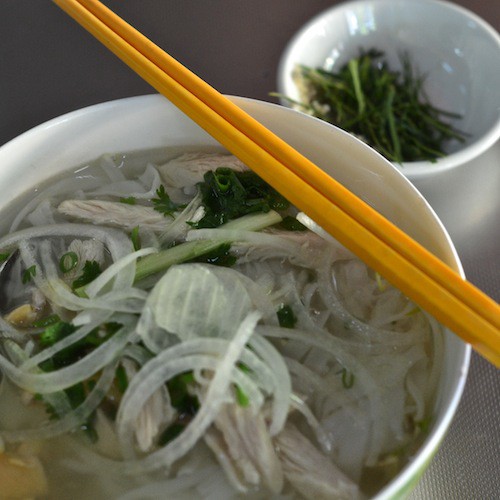
Ph? g is believed to have been invented in the 1930s when beef wasn?t sold in the markets in Vietnam on Mondays and Fridays.
This soup has a lighter, clearer broth than ph? b. It can be ordered as g n?c (lean chicken), with slices of breast meat, or bnh th??ng (normal), with chicken pieces of different texture, including some white breast meat, dark meat, skin and fat.
A less popular version of ph? g is lng g, which includes chicken gizzards.
Ph? C (fish pho)
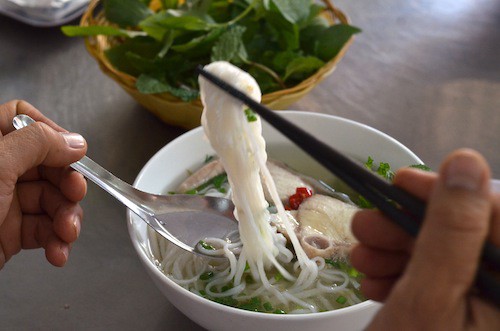
From necessity, Vietnamese people use local ingredients. In a country with 3,260 kilometers of coastline, there are many seaside towns where fresh fish is plentiful. So it seems only natural that fish ph? is available in coastal areas.
Ph? purists would argue that ph? c isn?t really pho at all. It?s bn c made with flat ph? noodles instead of thinner round bn noodles.
Fish ph? is a very light dish, with a clear fish-based broth and no cinnamon or star anise.
Ph? M?c (squid pho)
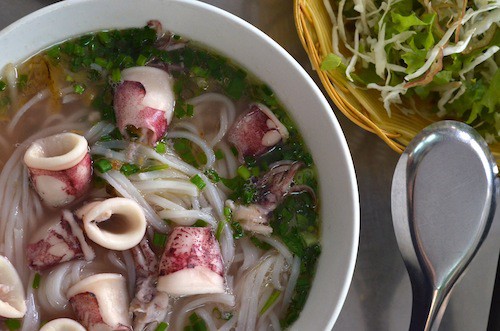
Squid ph? is another version that some say isn?t really ph?. Ph? m?c has a sweet pork broth, delicately flavored with ginger. The squid makes the broth cloudier than traditional forms of ph?.
Adding ph? herbs makes the dish taste decidedly ph?-y. The squid should be melt-in-the-mouth tender. Don?t forget to use the tangy tamarind dipping sauce that?s served with this dish.
Ph? Tu (stir-fried pho with pork)
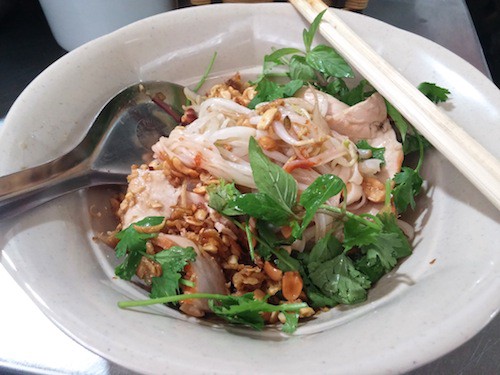
Ph? tu is a Hanoi dish with Chinese origins. It?s not a soup, rather noodles with a thick umami pork-based gravy, topped with slices of roast pork, bean sprouts, fresh herbs, peanuts, dried shallots and a dash of vinegar.
Ph? p Ch?o Gi?on (crispy fried pho noodles with beef)

Ph? noodles are double-fried to be crispy yet chewy in this dish (gi?on means crispy). There is a certain art to juggling all the required steps: frying the fresh ph? noodles into crispy cakes, then sauteing the beef slices, onion and marinade to make a meat and gravy mix.
The next step is to add slices of carrot, morning glory and shards of the crispy noodles.
The result should be a tasty beefy dish with a variety of textures of ph?, some of which soak up the gravy.
Ph? heo (pork pho)
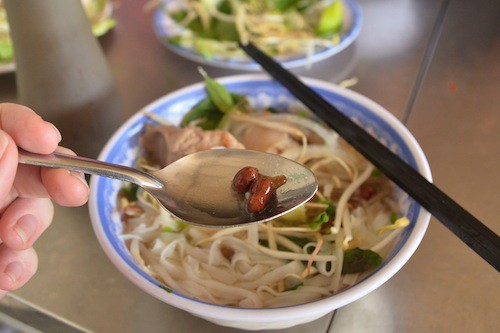 Pork pho (with peanuts)
Pork pho (with peanuts)
Vast areas of Central Vietnam used to belong to the ancient Hindu Kingdom of Champa. The Cham are now scattered throughout Vietnam, one of 53 ethnic minority groups. The Cham who still live in Central Vietnam remain Hindu, and so don?t eat beef.
Pork ph? has a mild pork bone-based broth and is usually served with a large chunk of boiled pork, instead of the thin slices of meat found in chicken and beef ph?. Sliced chili, lime wedges and a modest basket of fresh herbs are served with pork ph?, along with chili and hoisin sauce.
Ph? Cu?n (pho rolls)

Ph? cu?n may have been invented when someone couldn?t be bothered fetching enough water to make soup.
Ph? noodles are usually made by cutting sheets of steamed rice-flour noodles, similar to sheets of lasagne, into strips. Some enterprising (or lazy) person decided to leave the sheets uncut and use them to wrap a selection of typical ph? ingredients into a roll, similar to the Southern Vietnamese g?i cu?n, known in various parts of the world as fresh rice paper rolls or summer rolls.
G?i cu?n contains pork, prawn, fresh bun noodles, cucumber and fresh herbs wrapped in very thin, almost transparent, rice paper.
The ph? cu?n wrapper is thicker and the dish usually involves sauteed beef and fresh ph? herbs. The variant pictured above contains pork, prawn and ph? herbs, wrapped with ph? noodle sheets colored with beetroot, g?c fruit and pumpkin.
Ph? Chua (sour pho)

A specialty of the mountainous northern province of Lang Son, which borders China, ph? chua is more of a warm noodle salad than a soup.
Fresh ph? noodles are placed in a bowl, along with shredded chicken, a fried shrimp cake, a selection of offal, shredded morning glory, fresh herbs and roasted peanuts, and topped with a tangy tamarind sauce.
Pho Burger
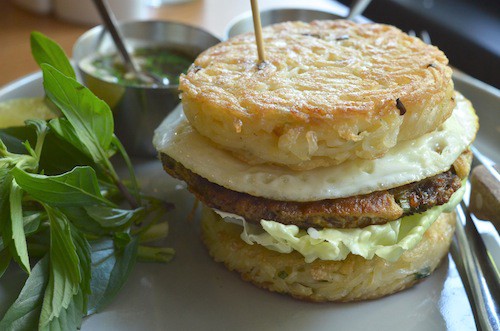
The pho burger was created as a monthly special by Relish & Sons burger joint in Ho Chi Minh City to mark the 40th anniversary of the end of the Vietnam War in April 2015. It?s proved so popular that it?s still on the menu more than a year later.
The pho burger bun is made from burger-shaped sections of fried ph? noodles. The beef pattie is infused with the herbs and spices of traditional ph? noodle soup. The burger also contains lettuce for crunch and a fried egg (because it?s a burger), sides of ph? broth and a spicy hoisin sauce, as well as the usual Southern selection of ph? herbs.
The Ph? Cocktail
In 1972, folk singer Joan Baez recorded the sounds of the Vietnam-American war from her hotel room in Hanoi. Forty years later at the same hotel, a young Vietnamese ph?-server-turned-bartender captured the flavors of the famous soup in a cocktail.
Pham Tien Tiep says his ?Joan Baez? ph? cocktail has the warmth of the singer?s voice as well all the flavors of Vietnam?s iconic noodle soup ? cilantro, cardamom, star anise, cinnamon and chili. In further homage to Hanoi?s war-torn history, Tiep?s cocktail is made using a ?bomb drop? method that sends burning alcohol down a ?tree? containing ph? spices.
The cocktail won Vietnam?s national bar-tending competition in 2012, making Tiep something of a national hero. He took his ph? cocktail to two new ventures in Hanoi, the Mojito Bar and the Unicorn Pub, which both still serve the drink.
Ph? Xo (stir-fried pho)
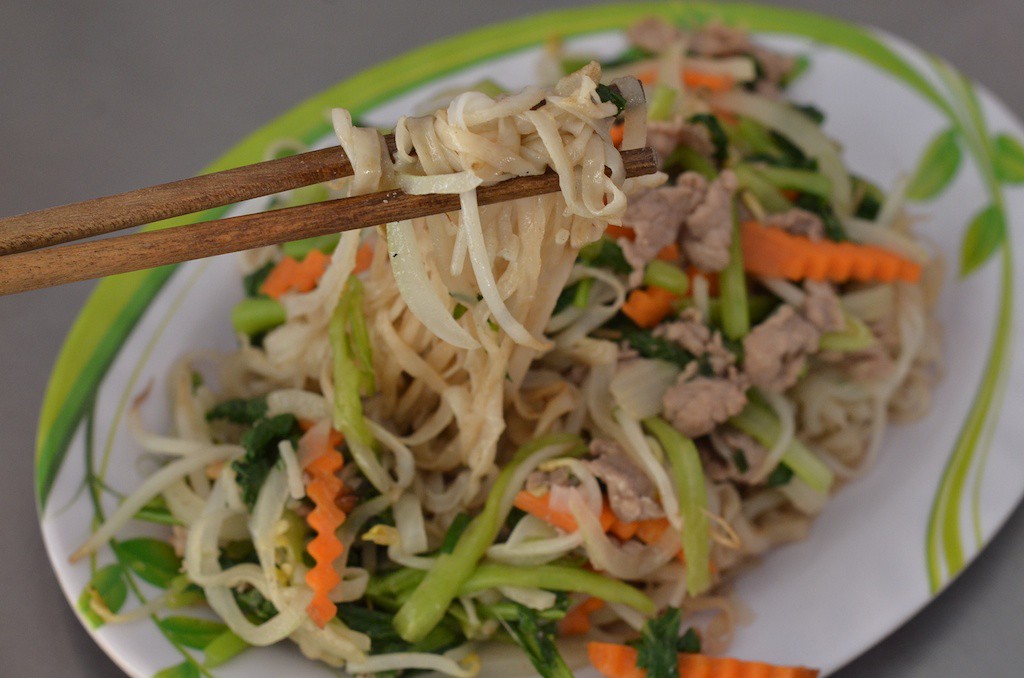
Ph? noodles are flash-fried in a wok, then placed on a flat plate. The remainder of the ingredients ? sliced beef (marinated in oyster sauce and sesame oil), carrot sticks, pok choi, sliced onions, bean sprouts and shallots ? are stir-fried with light and dark soy sauce.
The stir-fried meat and vegetables are ladled onto the noodles, which are slightly firmer than soup ph? noodles.
Ph? Tr?n (mixed pho)
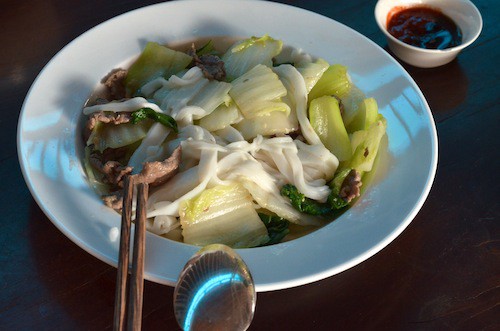
Ph? tr?n differs from ph? xo because only some of the ingredients are stir-fried.
Thin slices of beef are seared in a wok with bok choy and onion.
The meat and vegetables are then mixed with freshly boiled ph? noodles, which should remain soft, not chewy, oily or crispy.
Ph? Chay (vegetarian pho)
Ph? chay is a vegetarian noodle soup, with the stock made with carrots and daikon radish.
Mushrooms, tofu and/or mock meat are used in place of meat, and the accompaniments depend on whether you?re eating ph? chay in the north or in the south.
The one thing all these version of ph? have in common ? they?re all absolutely delicious. Well worth traveling to Vietnam to taste-test all the different types for yourself.
Follow Barbara on her blog, The Dropout Diaries, and on Instagram, Pinterest and Twitter. Also check out her new book, Vietnam: 100 Unusual Travel Tips.

